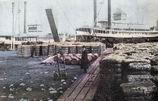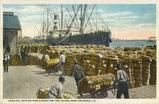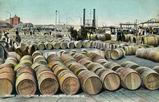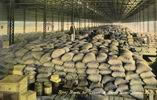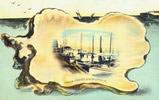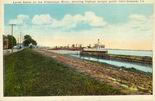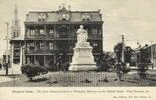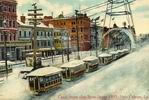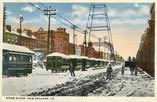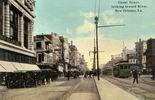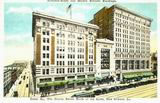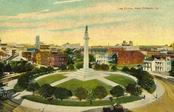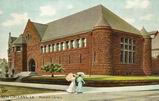|
|
Era:
1915-1929
Description: Mississippi River Steamboat
This is one of the sights of New Orleans. Every steamer carries more
or less cotton during the height of the cotton season. The boats are
loaded as high as the hurricane deck.
|
|
|
Era:
1907-1914
Description: Louisiana Products. Pretty Girls and the Cotton, New Orleans,
La.
Publisher: J. Scordill, 902 Canal St., New Orleans, La.
|
|
|
Era:
1907-1914
Description: Hauling Cotton and Louisiana Sugar, New Orleans, La.
|
|
|
Era: 1901-1907
Description: Cotton Wharf, New Orleans.
This city is the greatest cotton market in the world. Along its widning harbor front may be seen, in the season that follows the harvests of the south and west, the energies and activities of an exporting movement not excelled in volume or value on the American continent, save by New York.
|
|
|
Era: Curt Teich 1913
Description: LOADING COTTON FOR EXPORT ON THE LEVEE, NEW ORLEANS, LA.
Publisher: Curt Teich, Chicago
|
|
|
Era: 1907-1914
Description: SUGAR ARRIVING FROM PLANTATIONS, NEW ORLEANS, LA.
Publisher: F.M. Kirby & Co., Made in Germany
Ashleigh's Note: Glendale Plantation can be seen on a few of the barrels.
|
|
|
Era: Curt Teich 1908-1910
Description: Rice ready for Export in Shed, New Orleans, La.
Rice is one of the most important of the various products of Louisiana. The value of the crop runs into the millions of dollars, and is distributed to all parts of the United States, and exported to the West Indies, Central America, Cuba and Porto Rico. Rice is grown under water. Some of our Rice Fields are hundreds of acres in extent and give employment to thousands.
Postmark: Feb. 26, 1911
Publisher: Curt Teich, Chicago
|
|
|
Era: Curt Teich 1908-1913
Description: Lugger Landing, New Orleans, La.
The Lugger Landing is an uncovered wharf, one block below the French Market,
at which the Oyster Luggers, Fishing Boats, and Motor Freighters discharge their various
cargoes, presenting a busy and picturesque scene, well worth visiting. Take French Market
car from Canal St.
Publisher: Curt Teich, Chicago
|
|
|
Era:
1907-1914
Postmark: May 1918
Description: Moonlight on the Mississippi River -- There are thousands of lights used on the river after dark - but the moonlight reminds one of the romance and story of the old south.
|
| |
Era:
1907-1914
Description: Steamer Sydney, Largest Stern Wheel Steamer Afloat.
New Orleans, La.
Publisher: The Acmegraph Co., Chicago
|
| |
Era:
1915-1929
Description: Levee Scene on the Mississippi River, showing highest danger point, New Orleans, La.
This Levee Scene on the Mississippi River shows the highest danger point, where the river was kept from flooding the city of New Orleans, La. by an army of about 800 laborers.
Publisher: C.B. Mason, New Orleans, La.
|
| |
Era:
1915-1929
Description: Navigation Canal, New Orleans, La.
Connects the Mississippi River with Lake Pontchartrain and gives New Orleans a big addition to her harbor facilities.
Publisher: Tichnor
|
|
|
Era:
1893-1901
Description: " A Lady of Quality"
Private Mailing Card
Authorized by Act of Congress May 19 1898
|
|
|
Era:
1900-1907
Description: Margaret Statue.
The first Statue erected to a Woman's Memory in the United States.
New Orleans, La.
Publisher: Adolph Silege Pub. Co., St. Louis - Leipzig
Ashleigh's Note: Margaret Haughery, a baker woman, devoted her entire life to helping orphans in New Orleans.
|
|
|
Era: 1907-1914
Description: Canal Street after Snow Storm 1895, New Orleans, La.
Postmark: Nov. 14, 1911
Ashleigh's Note: 8 inches of snow fell on Valentine's Day 1895
That record snowfall stood until New Year's Eve December 31, 1963
|
|
|
Era: 1915-1929
Description: SNOW SCENE, NEW ORLEANS, LA.
This is an actual photograph of a freak of nature. In the winter of 1894-95, Snow and Ice went to the south most point of the United States. This picture is as great a curiosity here as roses in the open in January would be in the North.
Postmark: Dec. 13, 1917
|
|
|
Era: Curt Teich 1908-1910
Description: Canal Street, looking toward River, New Orleans, La.
Canal St. is the main thoroughfare of New Orleans. Up to 1838 a canal passed through the center of the street. It was filled up and the car tracks were placed upon the nuetral ground thus created. Canal St. is 170 feet wide, and is the point to which all the street cars in the city converge.
Publisher: Curt Teich, Chicago
|
|
|
Era: 1907-1914
Description: Audubon-Kress and Maison Blanche Buildings
Canal St., The Choice Retail Block of the South, New Orleans, La.
Postmark: May 6, 1918
Publisher: E.C. Kropp, Co., Milwaukee
|
|
|
Era: 1907-1914
Description: CARONDELET STREET NEW ORLENS, LA.
Publisher: "PHOSTINT" Card Detroit Publishing Co.
|
|
|
Era: 1907-1914
Description: Carondelet Street - "The Wall Street of New Orleans"
Key:
1 - City Bank Branch, Whitney Central Trust and Savings Bank
2 - Newman, Saunders and Co.
3 - New Orleans Bank and Trust Co.
4 - Hibernia Bank and Trust Co.
5 - New Orleans Cotton Exchange
6 - Marine Bank and Trust Co.
7 - Canal Commercial Trust and Savings Bank
8 - New Orleans Branch, Federal Reserve Bank of Atlanta
9 - New Orleans Stock Exchange, Gravier near Carondelet Street
Publisher: Compliments, Hibernia Bank & Trust Company
New Orleans, U.S.A.
|
|
|
Era: 1901-1907
Description: Lee Circle, New Orleans, La.
Postmark: Sept. 27, 1909
Publisher: New Orleans News Company, New Orleans, La.
Dresden-Liepzig-Berlin Made in Germany
|
|
|
Era: 1907-1914
Description: Howard Library
Howard Library, situated on the corner of Camp Street and Howard Avenue, was erected by Mrs. Annie Howard Parrot as a memorial to her father, the late Charles T. Howard. The Library has a handsome reading room, and contains about 35,000 volumes, besides a collection of rare books and maps.
Publisher: Raphael Tuck & Sons
Art Publishers to their Majesties the King and Queen
|
|
|
Era: 1901-1907
Description: New Orleans, La.
Layfayette Square
Publisher: Raphael Tuck & Sons
Art Publisher's to their Majesties the King and Queen
Printed in Germany
Ashleigh's Note: This is a statue of John McDonogh, an eccentric millionaire who left a fortune to Public Education in New Orleans and Baltimore, Maryland in the mid-1800's. In New Orleans, over 30 schools were built with his name along with the number of the school. The statue was finished in December 1898; and every May, on what was designated as McDonogh Day, the children would lay flowers by the statue in tribute to him as they sang the "McDonogh Ode" song:
O, wake the trumpet of renown,
Far-echoing a hero's name.
Oh, bring the shining laurel crown
That marks the glow of honored fame.
McDonogh! Let the trumpet blow
And with the garland twine his brow;
Extol him with your voices now:
Praise to him, all praise to him.
He sought not paths where glory shone
Nor dreamed of fame in Southern lore.
Twin cities claim him for their own,
New Orleans and fair Baltimore.
He gave his wealth to educate;
He lived that end to consummate;
His memory, then, perpetuate.
Praise to him, all praise to him.
McDonogh, unto thee we rear
A monument of fairest art
In memory of thy high career,
Enshrined within each grateful heart.
Now ready hands your offerings bring,
Now youthful tongues laudations sing
Until the heavens with echoes ring:
Praise to him, all praise to him.
|
|
|
Era: 1907-1914
Description: McDonogh Under a Blanket of Flowers, New Orleans, La.
John McDonogh left a large fortune to establish free schools for the children
of New Orleans, his only request was that they might lay a flower on his grave--
the first Friday in May is McDonogh day and delegates from hundreds of schools
deposit flowers, the result is bewildering.
Ashleigh's Note: I took the liberty of correcting the misspelling of McDonogh's name on the front description of the postcard.
|
|
|
Era: 1930-1944
Description: John McDonogh Monument, Lafayette Square
New Orleans, La.
John McDonogh, who became a recluse after being disappointed in love in New Orleans,
left half his large fortune to the cause of education in New Orleans. 32 public schools
have been built with the money he left. His monument in Lafayette Square was built
with the dimes of grateful school children and every year in May it is buried in flowers by
them.
Publisher: Louisiana News Company, New Orleans, La.
|




